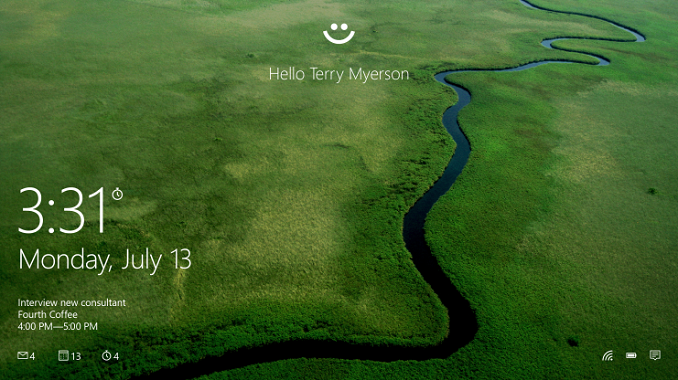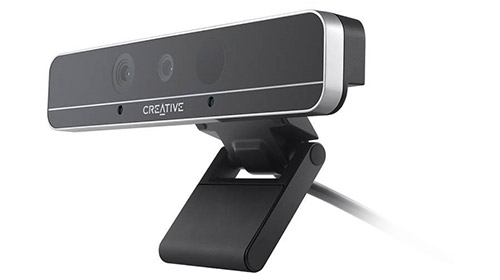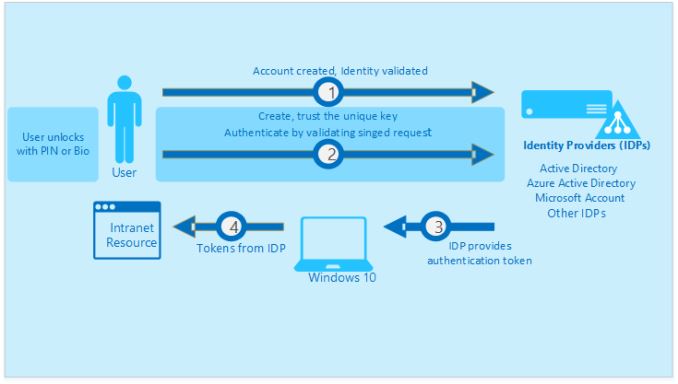The Windows 10 Review: The Old & New Face of Windows
by Brett Howse on August 25, 2015 8:00 AM EST- Posted in
- Operating Systems
- Microsoft
- Windows 10
Windows Hello and Passport
Welcome to the future. Windows 10 includes a new feature called Hello, which may change the way we log into our computers forever. Maybe that is a bit dramatic, but Windows Hello is a new framework which allows biometric logon to Windows, and it can include facial recognition, fingerprints, or even iris scanning technologies to authenticate you.
Now let’s take a step back. Windows has of course supported this in the past, and laptops have come with fingerprint readers for years. Much of that was through third party support, but you could easily set up Windows 8 to log in with a fingerprint. So this is not all new, but the new framework may be one of the biggest changes to come yet.
Windows Hello is meant to be a replacement for the traditional password logon. No one really likes passwords, but it is what we have, and therefore it is what we use. Maybe, just maybe, with Windows Hello we can start to move away from passwords. But, we are a long way from there yet. Let’s dig into Hello.
As I mentioned, laptops have come with fingerprint readers for years, and Windows 8 had native support for this (Windows 7 may have as well but I’ve not used a laptop with a reader on Windows 7) and you could pretty easily set it to log in. Windows Hello takes this to the next level with more options for login. At launch, there is support for fingerprints, iris scanning, or facial recognition.
In order to allow facial recognition but not easily be fooled by photos or other objects, Windows Hello requires an infrared camera. Right now, the only supported model is the Intel Real Sense 3D camera system, which was something that was shown off quite a bit at CES earlier in 2015. At the time, I wondered what the point of these 3D cameras were other than for some interesting demos, but clearly the companies were aware of this upcoming framework from Microsoft.
Microsoft has had some experience with this in the past. Kinect, which is an add-on for the Xbox, also allows facial recognition in order to log you in to it. I have to admit that my own experience with the Kinect for this function was so frustrating that I almost cheered the day they added the ability to automatically log into the Xbox One without the Kinect. So I was a bit skeptical about Windows Hello. One of the biggest issues I had on the Xbox One is that it would constantly think my eight year old son was me, and though people always say we look alike, I would think that the thirty extra years of age would make it somewhat obvious that we are not the same person.
I’ve been able to test out Windows Hello with the Intel Real Sense 3D camera dev kit, and I have to say the entire experience is almost perfect. It was incredibly easy to set up, and once configured, the entire process takes only around a second from the time it sees me to the time it logs me in. It seems much more accurate than Kinect, and part of that could easily be the distances it is used at versus the Kinect which often has to read my face from eight or ten feet away. But time after time, it quickly recognized me and logged me in, and once you experience it moving back to typing in a password is going to be a challenge.
I also tried to have it log in when my son was sitting in front of the PC, but he was not recognized, which is exactly how you want it to work. That's a pretty small sample size, but it's already better than Kinect was for me. The Australian had the resources to do a small test as well, but they were able to gather up six sets of idential twins. In none of the cases was the other twin able to unlock the device, so clearly there has been a lot of work to ensure that only the correct person unlocks the machine.
There are some extra security features too you can set up for Windows Hello. You can set it to not automatically unlock the screen if it sees you, which could be helpful in a corporate environment where you are near your computer but not at it, and you can also set it to have you turn your head from side to side before it will unlock, which should help with a more accurate unlock.
This is one of those features where once you first see and use it firsthand, it is almost a must have. I’m not sure if this will drive adoption of Windows 10 on its own, but I would certainly see it driving higher adoption for devices which include it versus those that do not. Hopefully we start to see this incorporated into desktop monitors as well.
Passport
Windows Hello is login, so what is Passport then? Passport is the next step. Windows Hello helps you log into your computer, and Passport is a service to help you log into everything else. This is another framework which can be leveraged in order to provide secure login to services without having to give them a password. There have been some pretty big cracks of online password databases in the last while, and any work to move to a new system which doesn’t require you to have a password at every location is something that will hopefully gain traction.
I think the most confusing aspect of Passport is its name. Passport was at one time the name of your Microsoft login, which was eventually named your Windows Live account, and now your Microsoft Account. It is also used in some other products like the Passport Authentication Protocol for WinHTTP. Confusing as it may be named, how it works is actually fairly simple.
Rather than authenticating with a username and password to a service or website, Passport will instead use a public/private key pair. The private key is stored in the machine and can be protected by the Trusted Platform Module (TPM) if it is present. Services or websites will get a copy of the public key. When a request to authenticate is made, the request is signed by the private key, which can then be opened by the public key.
But before all of this happens, Windows will prompt you to ensure you are in control of your device, using a PIN or Windows Hello. That way, if you leave your computer unlocked, people passing by can’t get access to your bank account using Passport.
None of this security technology is new, and that’s a good thing in the security world. Public/Private key pairs are what already powers all HTTPS traffic on the internet now.
The beauty of using a public key instead of a password is in the event the service is compromised. Attackers no longer gain access to a username and password which may or may not be the same one used by that person on many websites and services. Instead they get a public key, which can only be used to verify requests which come from the corresponding private key. Public keys are called that because they can and are made public for that single purpose.
Both of these technologies are a big step forward for the computer industry. We have already seen how much biometrics can help when looking at devices like the iPhone. For any inherent insecurity of using a fingerprint reader, the actual security is much higher than people using a four digit pin, or worse yet, nothing at all. Technologies like Windows Hello and Passport can be the solution to better security and ease of use. Hopefully both will gain traction with the ramp up of Windows 10.














293 Comments
View All Comments
prophet001 - Tuesday, August 25, 2015 - link
The spyware aspect of this OS bothers me. I'll be using Windows 7 until this is reconsidered.Michael Bay - Tuesday, August 25, 2015 - link
So, the same spyware.prophet001 - Tuesday, August 25, 2015 - link
Windows 7 doesn't even begin to approach this level of intrusion.Michael Bay - Tuesday, August 25, 2015 - link
As long as you believe that.wishgranter - Tuesday, August 25, 2015 - link
The Windows 10 EULA and Microsoft's Privacy Statement declare that Microsoft will access and use the content of people's emails and other files, such as documents uploaded to One Drive, according to Microsoft's discretion. "Share with our partners" also includes law enforcement, wherever Microsoft deems required. And I think Microsoft cannot ignore any instance which they feel should be forwarded to law enforcement without making themselves complicit in any potential criminal activity.Windows 10's all-your-contents-are-belongs-to-us policy is also a widening of the backdoor which law enforcement asks OS manufacturer to build into their systems.
Basically, Microsoft's Windows 10 EULA claims that all files used in Windows 10 may be accessed, searched, and contents utilized by Microsoft, with Microsoft exercizing sole discretion over what it will access, and how it will be used.
I think all businesses, content creators, and even nations should be dismayed at this. It looks like Russia already is concerned with Windows 10's always-on espionage against its users:
http://www.rt.com/politics/312172-windo ... ent-stirs/
If people will recall, Microsoft was previously found to be snooping in people's Outlook emails, and this discovery caused a furor among people, leading to Microsoft saying they would not do this anymore:
http://www.wired.com/2014/03/microsoft_vigilante/1
http://www.theverge.com/2014/3/20/55314 ... l-policies2
But now, Microsoft has made it a guaranteed policy of Windows 10 that they will always do this:
https://www.microsoft.com/en-gb/privacy ... fault.aspx
"Content. We collect content of your files and communications when necessary to provide you with the services you use. This includes: the content of your documents, photos, music or video you upload to a Microsoft service such as OneDrive. It also includes the content of your communications sent or received using Microsoft services, such as the:
- subject line and body of an email,
- text or other content of an instant message,
- audio and video recording of a video message, and
- audio recording and transcript of a voice message you receive or a text message you dictate."
Shouldn't there be a much bigger furor over the discretionless snooping of Windows 10, which includes all Outlook emails, than there was over just Outlook on its own?
Are people OK with their PCs contents no longer being their sole domain and in their privacy, but instead being fully open to Microsoft?
I'm not. I'll be sticking with Windows 7 for now.
Windows 10's motto: Your System is not Your Own
xenol - Tuesday, August 25, 2015 - link
You're reading the TP EULA. The actual Windows 10 EULA is at http://www.microsoft.com/en-us/Useterms/Retail/Win... , which defers the privacy stuff to Microsoft's privacy statement ( https://www.microsoft.com/en-us/privacystatement/ )Which says none or few of the things in the TP EULA (the only one I found in common is they may look at anything you upload to OneDrive, which you can disable on Windows 10 anyway)
Grooveriding - Tuesday, August 25, 2015 - link
Really unfortunate how far Microsoft went with privacy invasion and data trolling with Win 10. Fortunately you can disable what appears to be all of it with options, registry tweaks and disabling services.I would also recommend running a draconian firewall such as Tinywall that blocks all internet traffic and you have to allow applications on a case by case basis. As well as editing your hosts file to block all traffic back to Microsoft's data collection servers. As well, never use the OS with an MS account, just use a local account.
Pretty outrageous MS does not offer an option to disable everything without having to resort to these measures.
hansmuff - Tuesday, August 25, 2015 - link
The "sharing with law enforcement" is automatic for any data Microsoft has. If you're on 7 and use OneDrive, well there you go.Regarding the recording of voice data, that's a given with all of them. Siri, Google, now MS all use online services to improve detection and of course otherwise use that data. And they all send your recorded voice in some form or shape to their servers.
I can see how you'd tie it to Windows 10 because that centralizes a lot of those "new generation" of services that are in the cloud. But those services exist with or without Windows 10. I think it's wiser to educate people about what "the cloud" implies, which is exactly what you say; people do not have control over the data they store.
It's a cloud issue, and the cloud has provided the perfect vehicle for the likes of Apple, Google and Microsoft to take what they want. This goes for your PC, phone, tablet, everything.
Notmyusualid - Tuesday, August 25, 2015 - link
None of my phones or PCs send anything to the cloud.It is called privacy common sense.
Matts8 - Tuesday, August 25, 2015 - link
What phone do you have?